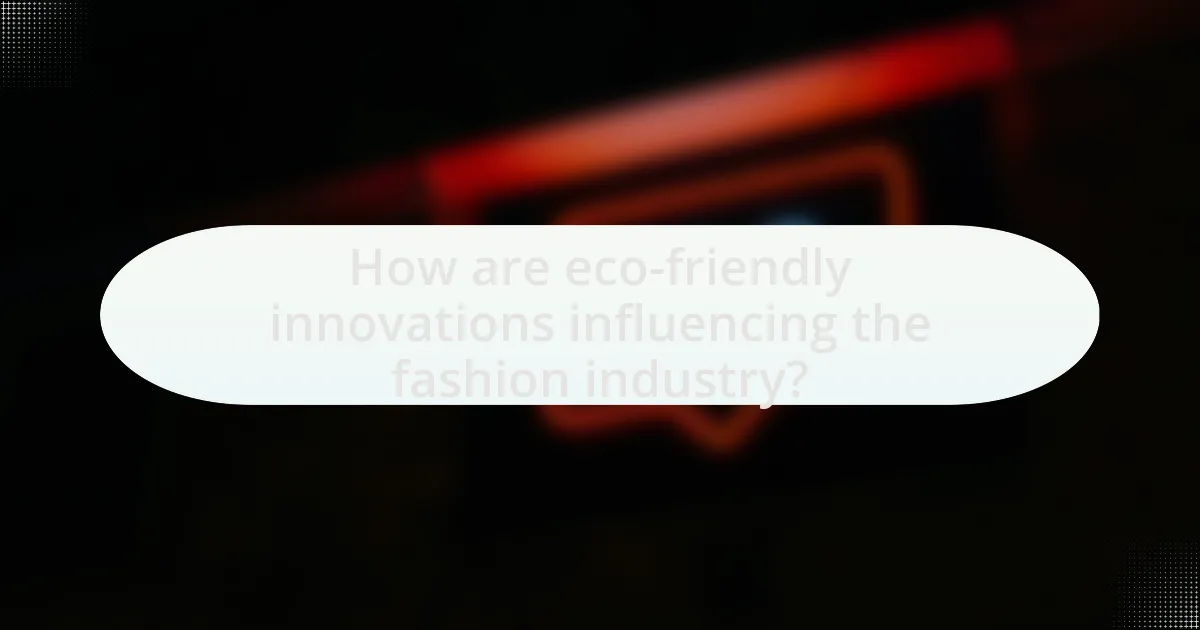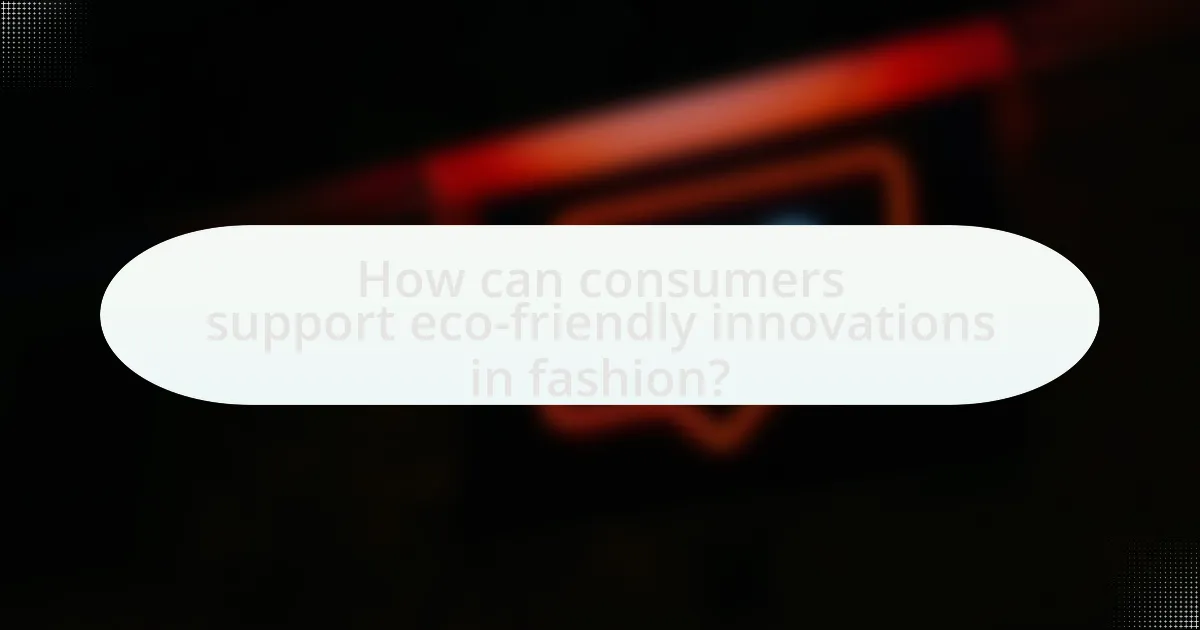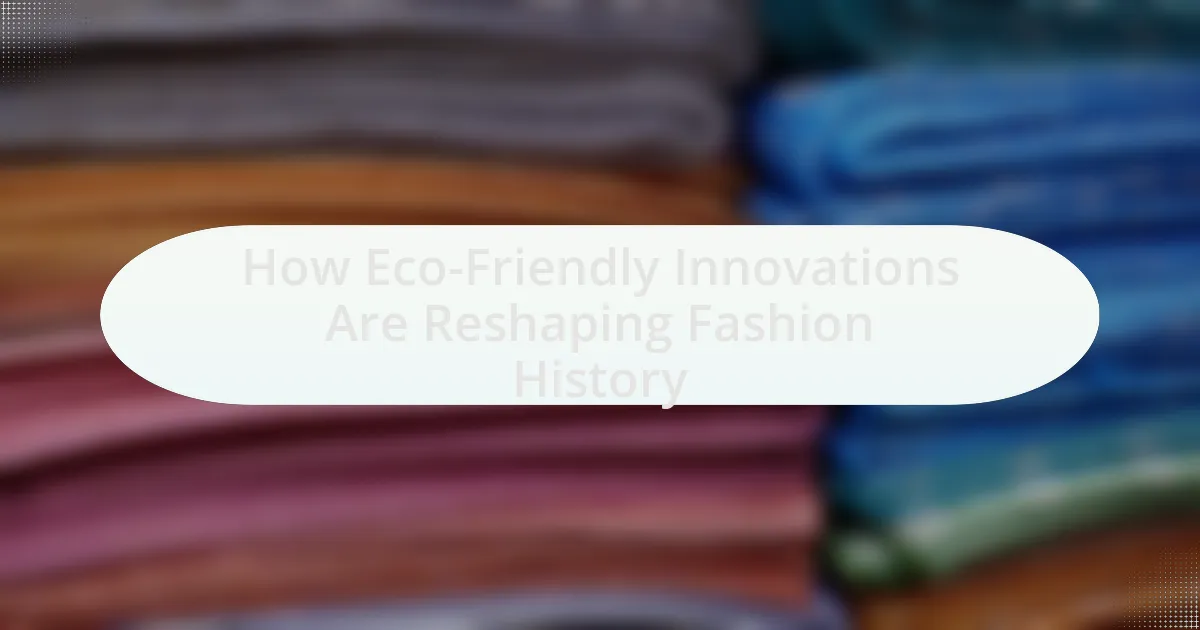Eco-friendly innovations are significantly reshaping the fashion industry by promoting sustainable practices and materials that minimize environmental impact. Key advancements include the use of organic cotton, recycled polyester, and innovative production techniques such as waterless dyeing and 3D knitting. The article explores the role of technology in enhancing sustainability, the historical context of the eco-friendly movement, and the challenges faced in adopting these practices. It also highlights the importance of consumer awareness and behavior in driving demand for sustainable fashion, as well as emerging materials that could revolutionize the industry. Overall, the article provides a comprehensive overview of how eco-friendly innovations are influencing fashion history and shaping a more sustainable future.

How are eco-friendly innovations influencing the fashion industry?
Eco-friendly innovations are significantly influencing the fashion industry by promoting sustainable practices and materials that reduce environmental impact. For instance, the adoption of organic cotton and recycled polyester has led to a decrease in water usage and waste generation, with organic cotton using 91% less water than conventional cotton. Additionally, brands like Stella McCartney and Patagonia are leading the way by implementing circular fashion models, which encourage recycling and reusing garments, thereby minimizing landfill contributions. These innovations not only enhance brand reputation but also cater to the growing consumer demand for sustainable products, as evidenced by a 2021 McKinsey report indicating that 67% of consumers consider sustainability when making a purchase.
What are the key eco-friendly innovations in fashion?
Key eco-friendly innovations in fashion include the use of sustainable materials, such as organic cotton, recycled polyester, and Tencel, which reduce environmental impact. Additionally, advancements in dyeing techniques, like waterless dyeing and natural dyes, minimize water usage and chemical pollution. Innovations in production processes, such as 3D knitting and zero-waste pattern making, enhance efficiency and reduce textile waste. Furthermore, the rise of circular fashion models, which promote recycling and upcycling of garments, supports sustainability in the industry. These innovations collectively contribute to a more environmentally responsible fashion landscape.
How do sustainable materials contribute to eco-friendly fashion?
Sustainable materials significantly contribute to eco-friendly fashion by reducing environmental impact through lower resource consumption and waste generation. For instance, organic cotton uses 91% less water than conventional cotton, minimizing water scarcity issues. Additionally, materials like Tencel, derived from sustainably sourced wood pulp, are produced in a closed-loop process that recycles water and solvents, resulting in less pollution. Furthermore, the use of recycled materials, such as recycled polyester, diverts plastic waste from landfills and reduces the need for virgin resources, thereby lowering carbon emissions associated with production. These practices collectively enhance the sustainability of the fashion industry, aligning it with eco-friendly principles.
What role does technology play in promoting eco-friendly practices?
Technology plays a crucial role in promoting eco-friendly practices by enabling sustainable production methods and reducing waste. Innovations such as 3D printing and digital textile printing allow for precise manufacturing, minimizing material usage and energy consumption. Additionally, advancements in materials science have led to the development of biodegradable fabrics and recycled materials, which significantly decrease environmental impact. For instance, the use of organic cotton and recycled polyester in fashion reduces water usage and pollution compared to conventional materials. Furthermore, technology facilitates supply chain transparency through blockchain, allowing consumers to make informed choices about the sustainability of their purchases. These technological advancements collectively contribute to a more sustainable fashion industry, aligning with eco-friendly practices.
Why is sustainability important in fashion history?
Sustainability is important in fashion history because it addresses the environmental and social impacts of the industry, which has historically contributed to pollution, waste, and exploitation. The fashion industry is responsible for approximately 10% of global carbon emissions and significant water usage, highlighting the urgent need for sustainable practices. By integrating eco-friendly innovations, such as organic materials and ethical labor practices, the industry can reduce its ecological footprint and promote social responsibility. This shift not only preserves resources for future generations but also aligns with consumer demand for transparency and ethical production, making sustainability a crucial aspect of fashion’s evolution.
How has consumer awareness shifted towards sustainable fashion?
Consumer awareness has significantly shifted towards sustainable fashion due to increased environmental concerns and the rise of ethical consumerism. This shift is evidenced by a 2021 survey from McKinsey & Company, which found that 67% of consumers consider the use of sustainable materials important when making fashion purchases. Additionally, social media campaigns and influencer endorsements have amplified awareness, leading to a growing demand for transparency in supply chains. The Fashion Transparency Index reported that 40% of major fashion brands now disclose their sustainability practices, reflecting a response to consumer pressure for accountability.
What historical events have shaped the eco-friendly movement in fashion?
The eco-friendly movement in fashion has been significantly shaped by several historical events, including the rise of environmental awareness in the 1960s and 1970s, the establishment of the first Earth Day in 1970, and the publication of Rachel Carson’s “Silent Spring” in 1962, which highlighted the dangers of pesticides. These events catalyzed public consciousness regarding environmental issues, leading to a demand for sustainable practices in various industries, including fashion. The introduction of the Global Organic Textile Standard (GOTS) in 2006 further solidified the movement by providing a comprehensive framework for organic textiles, ensuring environmentally and socially responsible production. Additionally, the 2013 Rana Plaza disaster in Bangladesh, which exposed the unsafe working conditions in the fashion industry, prompted a global outcry for ethical practices, reinforcing the need for sustainability and transparency in fashion.

What challenges do eco-friendly innovations face in the fashion industry?
Eco-friendly innovations in the fashion industry face significant challenges, including high production costs, limited consumer demand, and supply chain complexities. High production costs arise from the use of sustainable materials and ethical labor practices, which can lead to higher retail prices compared to conventional fashion items. Limited consumer demand is often driven by a lack of awareness or preference for fast fashion, which prioritizes low prices and rapid turnover. Additionally, supply chain complexities hinder the scalability of eco-friendly practices, as sourcing sustainable materials and ensuring ethical production can be logistically challenging. These factors collectively impede the widespread adoption of eco-friendly innovations in the fashion sector.
How do economic factors impact the adoption of sustainable practices?
Economic factors significantly influence the adoption of sustainable practices by determining the cost-effectiveness and financial viability of such initiatives. When businesses face high costs associated with sustainable materials or technologies, they may be less inclined to adopt these practices, as evidenced by a 2020 study from the Ellen MacArthur Foundation, which found that 60% of companies cited cost as a primary barrier to implementing circular economy strategies. Conversely, economic incentives, such as government subsidies or tax breaks for sustainable practices, can encourage adoption by reducing financial burdens. For instance, the U.S. government has provided tax credits for renewable energy investments, leading to increased adoption rates in various sectors. Thus, economic factors play a crucial role in shaping the willingness and ability of organizations to embrace sustainability in their operations.
What are the costs associated with eco-friendly materials?
The costs associated with eco-friendly materials are generally higher than conventional materials due to factors such as sustainable sourcing, production processes, and limited availability. For instance, organic cotton can cost up to 20% more than conventional cotton because it requires more labor-intensive farming practices and certification processes. Additionally, materials like Tencel, derived from sustainably sourced wood pulp, often have higher production costs due to environmentally friendly manufacturing methods. According to a 2021 report by the Global Fashion Agenda, the price premium for sustainable materials can range from 10% to 50% compared to traditional options, reflecting the investment in ethical practices and reduced environmental impact.
How does market demand influence sustainable fashion initiatives?
Market demand significantly influences sustainable fashion initiatives by driving brands to adopt eco-friendly practices to meet consumer preferences. As consumers increasingly prioritize sustainability, evidenced by a 2021 McKinsey report indicating that 67% of consumers consider sustainability when making a purchase, brands respond by integrating sustainable materials and ethical production methods. This shift not only aligns with consumer values but also enhances brand loyalty and market competitiveness, as companies that embrace sustainability can differentiate themselves in a crowded marketplace.
What are the barriers to widespread adoption of eco-friendly innovations?
The barriers to widespread adoption of eco-friendly innovations include high costs, lack of consumer awareness, and insufficient infrastructure. High costs deter both manufacturers and consumers from choosing eco-friendly options, as many sustainable materials and technologies are more expensive than conventional alternatives. Lack of consumer awareness limits demand, as many individuals are not informed about the benefits of eco-friendly products or the environmental impact of their choices. Additionally, insufficient infrastructure, such as limited recycling facilities and supply chain challenges, hinders the effective implementation of eco-friendly innovations in the fashion industry. These factors collectively impede the transition towards more sustainable practices in fashion.
How do traditional fashion practices conflict with sustainable methods?
Traditional fashion practices often conflict with sustainable methods due to their reliance on mass production, synthetic materials, and fast fashion cycles. Mass production leads to overconsumption and significant waste, as seen in the fact that the fashion industry generates 92 million tons of waste annually. Additionally, traditional practices frequently utilize non-biodegradable synthetic fabrics, which contribute to environmental pollution and microplastic contamination in oceans. Fast fashion, characterized by rapid turnover of trends, encourages a throwaway culture, undermining efforts to promote sustainable consumption and ethical production. These factors collectively hinder the adoption of eco-friendly innovations aimed at reducing environmental impact in the fashion industry.
What role do regulations play in promoting or hindering eco-friendly innovations?
Regulations play a crucial role in both promoting and hindering eco-friendly innovations. On one hand, stringent environmental regulations can incentivize companies to invest in sustainable practices and technologies, as seen in the European Union’s Green Deal, which aims to make Europe climate-neutral by 2050. This initiative encourages businesses to adopt eco-friendly innovations by providing funding and support for research and development. On the other hand, overly restrictive regulations can stifle innovation by imposing high compliance costs and limiting the flexibility needed for experimentation. For instance, the U.S. Environmental Protection Agency’s regulations on chemical usage can sometimes delay the introduction of new, safer materials in fashion. Thus, the balance of regulatory frameworks significantly influences the pace and direction of eco-friendly innovations in the fashion industry.

How can consumers support eco-friendly innovations in fashion?
Consumers can support eco-friendly innovations in fashion by choosing to purchase from brands that prioritize sustainable practices. By selecting clothing made from organic materials, recycled fabrics, or produced through ethical labor practices, consumers directly contribute to reducing environmental impact. For instance, a report by the Global Fashion Agenda indicates that sustainable fashion can reduce greenhouse gas emissions by up to 30% by 2030 if consumers shift their purchasing habits. Additionally, consumers can advocate for transparency in supply chains and support initiatives that promote circular fashion, such as clothing recycling programs. This collective consumer behavior fosters a market demand for eco-friendly innovations, encouraging more brands to adopt sustainable practices.
What are practical ways for consumers to choose sustainable fashion?
Consumers can choose sustainable fashion by prioritizing brands that use eco-friendly materials, such as organic cotton or recycled fabrics. Research indicates that the fashion industry is responsible for 10% of global carbon emissions, highlighting the importance of selecting brands that minimize their environmental impact. Additionally, consumers should look for certifications like Global Organic Textile Standard (GOTS) or Fair Trade, which ensure ethical production practices. Supporting second-hand shopping and clothing swaps also contributes to sustainability by extending the lifecycle of garments. Lastly, consumers can educate themselves on the environmental impact of their purchases, fostering informed decisions that promote sustainable practices in the fashion industry.
How can consumers identify eco-friendly brands?
Consumers can identify eco-friendly brands by looking for certifications such as Fair Trade, USDA Organic, or Global Organic Textile Standard (GOTS). These certifications indicate adherence to environmental and social standards in production. Additionally, consumers should examine the brand’s transparency regarding sourcing, manufacturing processes, and materials used, as brands committed to sustainability often provide detailed information on their practices. Research shows that brands with eco-friendly practices typically highlight their commitment to sustainability in marketing materials, making it easier for consumers to recognize them.
What impact does consumer behavior have on the fashion industry?
Consumer behavior significantly influences the fashion industry by driving trends, shaping brand strategies, and impacting sustainability practices. As consumers increasingly prioritize eco-friendly products, brands are compelled to adopt sustainable practices to meet this demand. For instance, a 2021 survey by McKinsey & Company revealed that 67% of consumers consider the use of sustainable materials important when making fashion purchases. This shift in consumer preferences has led to a rise in brands focusing on eco-friendly innovations, such as using recycled materials and implementing ethical production processes. Consequently, the fashion industry is evolving to align with consumer values, demonstrating that consumer behavior is a critical factor in shaping industry practices and trends.
What are the future trends in eco-friendly fashion innovations?
Future trends in eco-friendly fashion innovations include the increased use of biodegradable materials, advancements in circular fashion, and the integration of technology for sustainable practices. Biodegradable materials, such as mycelium leather and organic cotton, are gaining traction as brands seek to reduce waste and environmental impact. Circular fashion, which emphasizes recycling and upcycling, is becoming more prevalent, with companies like Patagonia leading the way in promoting repair and reuse. Additionally, technology is playing a crucial role, with innovations like 3D printing and blockchain for supply chain transparency enhancing sustainability efforts. These trends reflect a growing consumer demand for environmentally responsible practices in the fashion industry.
How might technology further enhance sustainability in fashion?
Technology can enhance sustainability in fashion through innovations such as 3D printing, which reduces waste by creating garments layer by layer, and digital fabric printing, which minimizes water usage and chemical waste compared to traditional dyeing methods. For instance, a study by the Ellen MacArthur Foundation highlights that 3D printing can cut material waste by up to 90% in some applications. Additionally, blockchain technology can improve supply chain transparency, allowing consumers to track the sustainability of their clothing, thereby promoting ethical practices. These technological advancements not only reduce environmental impact but also encourage a shift towards more sustainable consumption patterns in the fashion industry.
What emerging materials are set to revolutionize eco-friendly fashion?
Emerging materials set to revolutionize eco-friendly fashion include mushroom leather, recycled ocean plastics, and bio-fabricated textiles. Mushroom leather, derived from mycelium, offers a sustainable alternative to traditional leather, as it is biodegradable and requires fewer resources to produce. Recycled ocean plastics are being transformed into fabrics, reducing waste and promoting ocean conservation. Bio-fabricated textiles, such as those made from algae or bacterial cellulose, provide innovative options that minimize environmental impact while offering unique aesthetic qualities. These materials are gaining traction in the fashion industry due to their sustainability and potential to reduce reliance on conventional, resource-intensive materials.
What steps can individuals take to promote sustainability in their wardrobe?
Individuals can promote sustainability in their wardrobe by choosing to buy second-hand clothing, which reduces waste and the demand for new production. Research indicates that the fashion industry is responsible for 10% of global carbon emissions, and purchasing pre-owned items can significantly lower this impact. Additionally, individuals should opt for sustainable brands that prioritize eco-friendly materials and ethical labor practices, as these companies often use organic or recycled fabrics, which further minimizes environmental harm. Another effective step is to practice mindful consumption by evaluating the necessity of each purchase, thereby reducing impulse buying and fostering a more sustainable approach to fashion. Lastly, individuals can extend the life of their clothing through proper care and repair, which not only conserves resources but also promotes a culture of sustainability within the fashion industry.

Leave a Reply